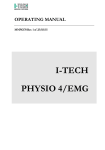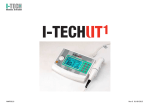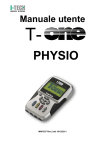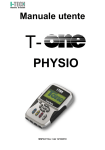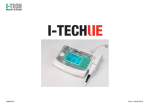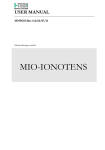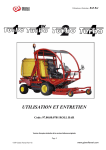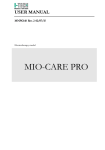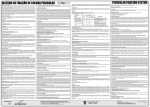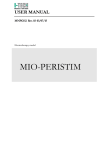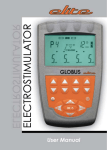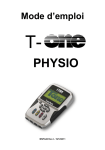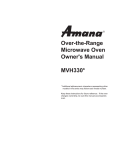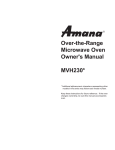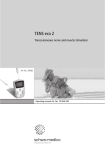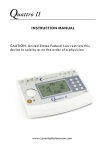Download T-ONE PHYSIO User manual (MNPG51-02) - I
Transcript
User manual TPHYSIO MNPG51 Rev.2 - 19/12/2011 IACER Srl SU T-ONE PHYSIO MNPG51-02 Ed. 19/12/11 Page 2 WARNING: T-ONE IS A MEDICAL DEVICE. Consult your doctor before using T-ONE if you suffer from health problems. Read the contraindications and warnings carefully before using the medical programs. Product in compliance with the MDD 93/42/CEE (as amended by 2007/47/EC) concerning medical devices. IACER S.r.l. SU Sede legale: S. Marco 2757, 30124 Venezia - Italia Sede operativa: via Pertini 24/A, 30030 Martellago (Venezia) - Italia. Tel. 041-5401356 Fax 041-5402684 e-mail:[email protected] www.iacer.ve.it IACER Srl SU T-ONE PHYSIO MNPG51-02 Ed. 19/12/11 Page 3 USER MANUAL INDEX 1. T-ONE kit contents; Page 5 2. Purpose Contraindications and side effects Page 5 3. Warnings Page 6 4. Legend of symbols marked on T-ONE and found in the manual Page 7 5. How to use T-ONE Description of controls – Preliminary instructions – Operating instructions Page 7 6. Battery charging Page 9 7. Declaration of conformity Page 10 8. T-ONE maintenance and storage Page 10 9. Resolution of problems and questions Page 11 10. Electrostimulation and T-ONE stimulation intensities Page 12 11. WAVE programs Page 13 12. REHAB programs Page 21 13. EMS programs Page 27 14. Programmable memories Page 36 15. SET UP Page 41 16. Self – adhesive electrodes Page 41 17. Technical specifications Page 41 18. Assistance Page 42 IACER Srl SU T-ONE PHYSIO MNPG51-02 Ed. 19/12/11 Page 4 1. T-ONE PHYSIO kit contents. n° n° n° n° n° n° n° n° n° n° 1 T-ONE PHYSIO electronic stimulator; 4 connection cables 2mm connection plug; 2 packages containing 4 pre-gelled self-adhesiv e 48x48mm electrodes; 2 packages containing 4 pre-gelled self-adhesiv e 50x90mm electrodes; 1 package containing 8 pre-gelled self-adhesive round 32 mm electrodes; 1 battery charger; 2 packages containing 4 rechargeable NI-Mh batt eries AA size; 1 T-ONE user manual; 1 electrode position manual. 1 Ionophoresis kit (sponges + elastic bend). Accessories and spare parts: • • • • Pre-gelled self-adhesive electrodes: 48X48mm • 50x90mm • round. 32mm; Ionophoresis pads: 60x80mm • 80x120mm; Elastic band for Ionophoresis treatment; Set 8 elastic bands for legs drainage. 2. Purpose. The T-ONE electronic stimulator is a medical device specifically intended for therapists and athletic trainers in public or private medical centres. It can be used in beauty shops by professional users except for medical programs. T-ONE electronic stimulator is intended also for adults with adequate knowledge of the device acquired from reading the manual for domestic use. We recommend to consult your doctor before using WAVE, REHAB and MEM programs. Contraindications. This device must not be used by people with a pace-maker, epileptics, pregnant women, anxious people or people suffering from heart disease, phlebitis, thrombophlebitis or serious illnesses. Microcurrent (W08), Ionophoresis (W09 and W10), Diadynamic (from W13 to W18), CP and LP current (W19 and W20), HVPC (W21) programs use monophasic impulses, so they are polarizing: do not use near metallic prosthesis under skin (minimum 10cm from metallic prosthesis). In the event of injury, muscle stress or any other health problem use the device only under medical supervision. Side effects No significant side effects are known. Some particularly sensitive people have reported skin redness in the area where the electrodes were positioned: the redness usually disappears a few minutes after the end of the treatment. Should the redness persist please consult a doctor. In rare cases, stimulation carried out in the evening can cause some people to experience difficulty in falling asleep. If this occurs, suspend the treatment and consult a doctor. IACER Srl SU T-ONE PHYSIO MNPG51-02 Ed. 19/12/11 Page 5 3. Warnings. T-ONE has been designed and manufactured to be operated with 4 rechargeable batteries AA size 1,2 V or 1,5 V with power higher than 1500mA. • The device doesn’t produce or receive electromagnetic interferences from other devices. However it’s recommended to keep a distance of at least 3 meters from televisions, monitor, mobile phones or other electronic devices. • Use of battery is prohibited in the presence of acid loss in order to avoid short-circuit. • The device must not be used in the presence of patient monitoring equipment. • Do not use T-ONE with electrosurgical or shortwave or microwave therapy equipment. • Use of the device is prohibited to persons known to be of unsound mind, to persons suffering from sensibility disorders, to permanently or temporarily disabled persons unless assisted by qualified personnel (e.g. a doctor or therapist). • Use of the device is prohibited in the presence of signs of deterioration of the device itself. • Use of the device is prohibited in the open air or next to liquid substances to avoid liquid penetration into the device. Should any foreign matters penetrate the device contact the retailer or manufacturer immediately. If dropped, check that the housing is not cracked or damaged in any way; if so, contact the retailer or manufacturer. Should you notice any changes in the device’s performance during treatment, interrupt the treatment immediately and consult the retailer or manufacturer (patients being treated in a centre must also be informed of the event). • Use of the device is prohibited close to flammable substances or in environments with high concentrations of oxygen. Muscle heaviness and cramps may be experienced in the event of prolonged muscle stimulation. Should this occur we recommend suspending treatment with T-ONE for a few days and then continuing with muscle recovery and capillarization programs. Make sure that the plug and battery charger are intact. Should one of these parts show any sign of damage, suspend use of the battery charger immediately and contact the retailer or manufacturer. Only use battery chargers supplied by the manufacturer; the use of battery chargers not supplied by the manufacturer will free the same from any responsibility related to damage to the equipment or user. • It is forbidden to position the electrodes in such a way that the current crosses the heart area (e.g. a black electrode on the chest and a red electrode on the shoulder blade); however electrodes can be positioned along the muscular fascia of the heart area, as used for pectoral strengthening. • The electrodes must not be positioned on the carotid sinuses (carotid) or genitals, close to the eyes, on or close to injuries or cuts. Make sure that the current delivered does not cross the eyeball (one electrode diametrically opposite to the other in relation to the eye); keep a distance of at least 3cm from the eyeball. • When using the electrodes, follow the instructions given in this manual and on the package of the electrodes themselves. Use single-patient electrodes, supplied exclusively by the manufacturer or retailer, and take great care to avoid the exchange of electrodes between different users. • Use electrodes supplied exclusively by the manufacturer; T-ONE has been tested and guaranteed for use with the electrodes supplied. Different electrodes can provoke skin reactions or burns. Round electrodes must be used only for face treatment. • Do not use electrodes when damaged, even if they stick to the skin well. • Electrodes must not be used when they no longer stick to the skin. Repeated use of the same electrodes can compromise the safety of the stimulation, in fact it can cause skin redness that can last for many hours after stimulation. • Warning! During treatment with round electrodes, current density may be in excess of 2 mA/cm² for each electrode. In these cases take special care regarding any skin redness. IACER Srl SU T-ONE PHYSIO MNPG51-02 Ed. 19/12/11 Page 6 • Do not use anal or vaginal probes in event of skin or muscle injuries. Do not use without a medical prescription. Useful life of product: 5 years. 4. Legend of symbols marked on T-ONE and found in the manual. Manufactured in compliance with MDD 93/42/EEC (and 2007/47/CE) concerning medical devices. Internally powered device with type BF applied parts. Product subject to WEEE regulations concerning separate waste collection. Read the instructions for use carefully before using the device. ON/OFF button. Select program and muscles to stimulate. Multifunction buttons: select WAVE, REHAB, EMS and MEMS programs, male, female and skip phase. Start/Stop program, confirm selection and pause. Increase intensity. Decrease intensity. 5. How to use T-ONE. IACER Srl SU T-ONE PHYSIO MNPG51-02 Ed. 19/12/11 Page 7 Preliminary instructions. Before using T-ONE clean the skin of the area to be treated; with the cable disconnected from T-ONE, connect the electrostimulation cable jacks to the self-adhesive electrodes; position the self-adhesive electrodes on the skin (see photos of electrode positions); connect the impulse transmission cables to the relative jacks (Channel 1 and/or Channel 2), then turn T-ONE on. Operating instructions. (N.B. read the whole manual before using the equipment). 1. Turn T-ONE on using the button, keeping it pressed at least 1second. 2. Select the program group: Wave, Rehab, EMS, Mem using the button 3. Select the program using the 4. buttons. Select male or female with buttons (if expected). Male Selection 5. Select the muscle group with arms male trunk male . Female Selection buttons. legs male arms female trunk female legs female 6. Press to start program; the display shows connect cables and electrodes and increase intensity of the used channels; to start intensity press for each used channel; T-ONE will begin the session. 7. Press the button for each use channel to increase current intensity until the personal tolerance level is reached. IACER Srl SU T-ONE PHYSIO MNPG51-02 Ed. 19/12/11 Page 8 A bar indicating the start and end of a contraction will appear on the display while the electronic stimulator is working. The periods of muscular contraction (bold bar) and the periods of recovery (dotted or striped bar) are graphically visualised under the bar with a cursor. This enables the user to know exactly when a contractions starts. 8. At the end of the first phase, the T-ONE cancels the previously selected intensity, and warns the user with an intermittent signal; to continue with the program, press the button for the relevant channels again until you reach the desired level of stimulation. An audio signal will sound three times when the program has finished. 9. At the end of the program switch off the T-ONE and remove the cables. Attach the electrodes to the transparent films and replace them in their original packaging. Option to simultaneously increase the intensity on all channels: Select the desired program: Start program Increase each channel to at least intensity 1: CH1 CH2 CH3 CH4 Red White Blue Yellow To simultaneously increase the intensity of all channels use the following buttons: Increase Skip phase: press Decrease button during the working program to skip to the next phase. Pause/stop program: during the working program, press the momentarily pause the normal working cycling. Press the program. Press the button twice consecutively to stop the program. button once to button again to restart the 6. Battery charging. The display shows when the battery is low of energy: Batteries fully charged Batteries partially discharged Batteries fully discharged BATTERY CHARGER SPECIFICATIONS: see battery charger datasheet. Use only battery charger supplied by the manufacturer or by authorized dealers. Using other battery chargers can seriously compromise equipment and user safety. Use only batteries AA size like the ones supplied with the equipment (rechargeable Ni-Mh AA 1,2V or Alkaline AA 1,5V ). The manufacturer is not responsible for damages due to the use of different batteries. WARNING: do not recharge other batteries than the ones supplied with Ni-Mh battery charger. Do not mix new (or recharged) batteries with discharged batteries. IACER Srl SU T-ONE PHYSIO MNPG51-02 Ed. 19/12/11 Page 9 Do not dispose of discharged or defective batteries with domestic waste; dispose of in an authorised waste collection bin. IMPORTANT: do not leave discharged batteries into the device when it’s not in use for long time. Before storing T-ONE for long periods of time, we recommend that it is fully charged and stored in a dry place, checking that it is switched off. Recharging instructions: • Insert the rechargeable batteries into the charger respecting the indicated polarity. • Connect the charger to the domestic plug 220/230 VAC. • The batteries need 8/12 hours for a complete charge. • During charging, both batteries and charger get warm: this is a normal condition and do not imply any danger. WARNING disconnect the battery charger from domestic plug when not in use. WARNING: disconnect electrodes during battery recharging. We recommend to recharge battery always for 8/12 hours regardless of light (red or green) on the battery charger. Do not use battery charger if it has been exposed to rain or any other type of liquid, plug is damaged or parts of it are broken, the components have been damaged by a fall. Do not immerge the battery charger in water. Use a dry cloth to clean the battery charger. Do not open the battery charger: it does not contain repairable parts. 7. Declaration of conformity IACER S.r.l., headquartered in Italy, via S. Pertini 24/A 30030 Martellago (VE), declares on its own responsibility that the device of T-ONE family, T-ONE PHYSIO model, is manufactured in conformity with Council Directive 93/42/EEC (MDD) dated 14 June 1993 (D. Lgs. 46/97 dated 24 February 1997 “Attuazione della Direttiva 93/42/CEE concernente i dispositivi medici). T-ONE PHYSIO is a Class IIa equipment, with reference to Directive 93/42/EEC (MDD), annexed IX rule 9 (and following modifications) as amended by MDD 2007/47/EC. Notified body: Cermet Scarl, Via di Cadriano 23, 40057 Cadriano di Granarolo (BO) Martellago, 05/04/2010 Legal representative Mario Caprara 8. T-ONE maintenance and storage. We recommend that T-ONE is switched off and the cables are removed from the connectors at the end of every session. T-ONE should be kept in the carry bag supplied, together with the rest of the equipment supplied with it, and carefully stored on a secure surface and protected from situations listed in the Warnings paragraph. T-ONE should be stored in the following conditions: Temperature: Maximum relative humidity: Atmospheric pressure: from –20°C to +40°C 75% from 700 hPa to 1060 hPa Cleaning: only clean the device using a dry cloth. IACER Srl SU T-ONE PHYSIO MNPG51-02 Ed. 19/12/11 Page 10 We recommend that the device be subjected to a functional test carried out by the manufacturer every 18 months. The manufacturer retains that the T-ONE device cannot be repaired by personnel external to its own company. Any work of this nature carried out by personnel not authorised by the manufacturer will be classed as tampering with the device, freeing the manufacturer from responsibility for the warranty and hazards that the operator or user may be exposed to. N.B. disconnect the cables before placing the electronic stimulator in the bag. If not, the cables will bend excessively close to the connectors. This may damage the cables. 9. Resolution of problems and questions. Any type of work on T-ONE must be carried out exclusively by the manufacturer or by an authorised dealer. In any event, any presumed malfunction of T-ONE must be verified before sending the device to the manufacturer. Here below are some typical situations: T-ONE cannot be turned on: • Ensure of presence of batteries in the unit. • Recharge the batteries and try to switch it on again. • Ensure of absence of oxide on batteries contact, clean with a dry towel and try to turn it again. • Check that the ON/OFF button has been pressed correctly (keeping it pressed at least 1second). • Check that batteries have been inserted according to correct polarity. T-ONE does not transmit electric impulses: • Check that the cable jacks have been inserted in the electrodes and that the plastic protection has been removed from the electrode. • Check that the cables have been connected correctly (connector well inserted in the device). • In the event that impulse is present only keeping down electrode on skin, replace it with a new electrode. T-ONE switches off during operation: • Recharge or replace the batteries and start the treatment again. Disposal To protect the environment, the device, its accessories and above all the batteries must be disposed of in areas equipped for that purpose or as special waste. Product subject to WEEE regulations concerning separate waste collection. IACER Srl SU T-ONE PHYSIO MNPG51-02 Ed. 19/12/11 Page 11 10. Electrostimulation and intensity stimulation. Electrostimulation consists of the transmission of electric micro-impulses to the human body. Fields of application of electro-stimulation are: pain therapy, recovery of muscle trophism after injury or a surgical operation, athletic preparation and beauty treatments. Specific electric impulses are used for every one of these applications. The stimulation intensity is displayed on the T-ONE screen for each channel in a scale progressing from 0 to 120. In Sport and Beauty programs intensity differs according to specific muscle o selected program. The following description helps the user to choose correct intensity in according to used impulse. Impulse categories are: 1. Tens impulse: for tens programs the intensity should be adjust to a level between the thresholds of perception and pain. The maximum limit is reached when the muscles surrounding the area treated begin to contract. It is best to stay below that limit. 2. Micro-current impulse: maximum adjustable intensity is 12, so very low. Intensity can be adjusted between 6 and 12 and it might almost undetectable: it’s not a malfunctioning but it’s the normal functioning of device. 3. Ionophoresis impulse: the intensity must be strong enough to produce a relevant perception, near pain, till the muscles surrounding the area treated begin to contract. Maximum adjustable intensity: 50. 4. EMS impulse: in this case it will be produced a stimulation with a gradual increasing intensity in order to increase gradually the metabolism of treated muscle. As that happens with own car: engine has to be warmed up before it arrives to maximum speed. 5. Toning, training, atrophy contraction impulse: the muscle treated must visibly contract during a training impulse. The fact that the muscle tends to stiffen and increase in volume will be visible to the naked eye. Intensity should be increased gradually (in the first contraction) to enable you to identify the right level of stimulation comfort. Intensity can be increased up to the personal tolerance threshold during the second training contraction; this operation is then repeated during each contraction until the workload reaches the level of intensity recommended in the description of the single programs. We recommend that you record the level of intensity reached in order to try to improve the level of stimulation and consequently your performance. 6. Massage, winding down, active recovery impulse: intensity must be adjusted gradually to massage the muscle treated. The level of intensity should be sufficient to obtain a comfortable massage. Bear in mind that there is no need to endure high intensity levels in this case as it is meant to be a massage, meaning that intensity can be increased gradually without excesses. 7. Capillarization impulse: increase the intensity gradually to produce constant, visible stimulation of the area treated; a medium stimulation threshold is recommended, always below the pain threshold. 8. Lypolisis/drainage impulse: the “pump” effect is produced by sequential tonic contractions. The intensity must be enough to produce these contractions: the greater the contraction is, the greater the pump effect will be. But beware: there is no benefit to be gained from enduring intensity high enough to cause pain. The first electrostimulation sessions should be carried out at a low intensity to allow the organism to get used to new sensations. That way intensity can be increased gradually and will not be traumatic. 9. Other impulses: see program details. IACER Srl SU T-ONE PHYSIO MNPG51-02 Ed. 19/12/11 Page 12 11. WAVE Programs. WARNING! It must be remembered that an electronic stimulator is a very effective analgesic instrument and that pain can indicate various types of medical conditions! Most of programs described in this paragraph are analgesic. You are advised to read the manual carefully before using T-ONE. REMEMBER THAT PAIN IS A SIGN: consult a doctor to identify the medical condition before using T-ONE! TENS, an acronym standing for “transcutaneous electrical nerve stimulation”, is a therapeutic technique mainly used for analgesic purposes to counter the effects (usually pain) of a wide variety of medical conditions. For this purpose it finds application in treating everyday ailments troubling mankind: neck pain, arthrosis, myalgia, neuritis, back pain, periarthritis, heaviness in legs, muscle weakness, just to mention a few. On an academic level, TENS can be divided into various categories according to the mechanism used to reduce the pain. The main types are: conventional TENS (or fast analgesic), electro acupuncture training TENS (or delayed analgesic), TENS sequential where stimulation parameters are modified automatically by program itself during the treatment, TENS at maximum values with antidromic action and consequently an immediate local anaesthetic effect, TENS burst that is a mix between conventional and electro acupuncture training TENS. The rehabilitative action of TENS is represented by its power to reduce pain thereby restoring physiological conditions; more often than not this allows the patient to regain normal motor function. Consider a patient suffering from irritating periarthritis; they either resort to using analgesics or learn to live with the pain that often makes even the simplest movements impossible. Immobility reduces metabolic activity making it impossible to eliminate algogenic substances. So a vicious circle begins. In addition to relieving pain, TENS causes induced muscle stimulation increasing metabolic activity and blood flow and improving tissue oxygenation with an intake of nutritional substances. So the positive effect can be amplified by combining TENS with muscle stimulation of the area concerned. Position of electrodes and intensity levels. The electrodes should be positioned to form a square surrounding the painful area using Channel 1 and Channel 2 as shown in illustration 1. The intensity should be adjusted to a level between the thresholds of perception and pain: the maximum intensity level is the moment in which the muscles surrounding the area treated begin to contract; over this limit stimulation does not become more effective, just more irritating, so it is best to stop before that point. IACER Srl SU T-ONE PHYSIO MNPG51-02 Ed. 19/12/11 Page 13 Illustration 1 WARNING Create a square area with the electrodes, over the painful zone. Keep 4cm minimum distance between electrodes. W01 • Rapid TENS. (Medical Program). Program also called conventional tens, used for analgesic purposes; its purpose is to induce the organism into blocking pain at the spine, in accordance with the “Gate Control Theory” by Melzack and Wall. Pain impulses leave part of the body (for example the hand) and run along the nerve tracts (through small-diameter nerve fibres) until they reach the central nervous system where the impulses are interpreted as pain. Conventional tens activates large-diameter nerve fibres, blocking the path of small-diameter nerve fibres at the spine. So action is mainly taken against the symptom: to simplify it further, the wire transmitting pain information is obstructed. Treatment duration should be no less than 30/40 minutes. Conventional tens is a current that can be used to treat general everyday pain. The average number required to benefit from the treatment is 10/12 per day (there are no contraindications for up to double this amount). The program has a duration of 30 minutes in a single phase. The program can be repeated at the end of the session for particularly persistent pain. Position of electrodes: form a square above the painful area as shown in illustration 1. Intensity: should be adjusted to a level between the thresholds of perception and pain: the maximum intensity level is the moment in which the muscles surrounding the area treated begin to contract (over this limit stimulation does not become more effective, just more irritating, so it is best to stop before that point). W02 • Endorphinic TENS 0,5 Hz Frequency. (Medical Program). This type of stimulation produces two types of effects according to how the electrodes are positioned: positioning the electrodes in the dorsal region, see photo 08 in the positions manual, promotes the endogenous production of morphine-like substances capable of raising the pain perception threshold; positioning the electrodes to form a square above the painful area as shown in illustration 1 produces a vascularizing effect. Vascularization increases arterial flow and consequently aids the removal of algogenic substances and helps to restore normal physiological conditions. Treatment duration 20 minutes in a single phase, daily frequency. Do not position the electrodes close to inflamed areas. Intensity: adjusted for good solicitation of the part stimulated (15÷30), the sensation must be similar to that of a massage. W03 • Endorphinic TENS 1 Hz Frequency. (Medical Program). See previous program description, but with 1 Hz frequency. W04 • Endorphinic TENS 2 Hz Frequency. (Medical Program). See previous program description, but with 2Hz frequency. IACER Srl SU T-ONE PHYSIO MNPG51-02 Ed. 19/12/11 Page 14 W05 • TENS sequential. (Medical Program). The action of this program is very similar to the one of W01 program. During stimulation, this program modifies by itself the frequency and impulse width so to contrast the habit at the stimulation (no need to continuously adjust the intensity value). Select the intensity at the beginning of the program and maintain it till the end of the program. In the event during the program current perception decreases a lot, do not increase intensity value and wait till the end of therapy. TENS program is working properly. Program duration: 20 minutes for each phase. Intensity: set above the threshold of perception. Position of electrodes: form a square on the painful area as shown in illustration 1 or see pictures from 25 to 33. W06 • TENS at maximum values. (Medical Program). Very short duration, 3 minutes. Blocks pain impulses peripherally creating a proper anaesthetising effect in the area treated. This type of stimulation is suitable for injuries or bruises when rapid action is required. The intensity selected is the maximum tolerable value (well in excess of conventional tens, and therefore with considerable contraction of the muscles surrounding the area treated). That is the reason why such stimulation is undoubtedly the least tolerated but is extremely effective. This type of stimulation is not recommended for particularly sensitive people and in any case the electrodes should not be positioned in sensitive areas such as the face and genitals or close to wounds. Position of electrodes: form a square on the painful area as shown in illustration 1 or see pictures from 25 to 33. W07 • TENS Burst impulse. (Medical Program). This program produces a training effect using the frequencies of conventional TENS. Useful for pain therapy. The action is similar to the one of endorphinic TENS, with a treatment time of 15 minutes for a phase. Position of electrodes: form a square on the painful area as shown in illustration 1. Intensity adjusted for good solicitation of the part stimulated (15÷30mA), the sensation must be similar to that of a massage. W08 • Microcurrent (MENS). (Medical Program). MENS releases a very low and not much perceptible current. Main features of MENS are: • correct body bioelectric currents when they have been altered by diseases; • analgesic action; • ATP production (ATP production promotes proteins synthesis and a faster wound healing); • Oedema reduction: MENS is able to reduce vascular permeability with an improvement of lymphatic activity. It’s a program suitable for more delicate parts of the body (face, close to genitals, inflamed areas) or for people that don’t tolerate conventional TENS very well. Program duration: 30 minutes. Maximum intensity limited to 12. We recommend to set intensity level between 6 and 12. IACER Srl SU T-ONE PHYSIO MNPG51-02 Ed. 19/12/11 Page 15 Table of correspondences adjusted/effective current: Adjusted intensity displayed on screen 0,5 1 3 5 9 12 Effective current 0,15 mA 0,30 mA 0,90 mA 1,5 mA 2,7 mA 3,6 mA W09-W10 • Ionophoresis 1 / Ionophoresis 2. (Medical Program). Ionophoresis is an electrotherapeutic technique that uses continuous current to carry drugs into painful area or contracture area. Ionophoresis means “ions transport”: through continuous current, active pharmacologic ions are driven through the skin. Electric current favours drugs penetration into the cells, and at the same time it stimulates the elimination of metabolic slag. The drug can have negative polarity, positive polarity or double polarity. The current induce the drug to run from one pole to the other, crossing the painful area and releasing the specific active ingredient. WARNING: before starting the therapy, wet the sponge electrodes and wring them so to avoid dripping, then put the drug on the electrode as follow: • Active polarity drug: dissolve this drug on the electrode connected to positive pole (red connector). • Negative polarity drug: dissolve this drug on the electrode connected to negative pole (black connector). • Double polarity drug: can be dissolved on positive pole or negative pole without distinction. Position the electrode with the drug on painful area, and the other electrode on the other side. Program duration: 20 minutes. Select channel 1 or channel 2 (select both channels only if you need to stimulate two different areas). Position the electrodes (positive and negative) horizontally to the treatment area. Channels 3 and 4 are disconnected. Set up an intensity value so to have “pins and needles” on treatment area. At the end of the program, the skin could lightly turn bright red; the reddening usually vanishing few minutes after the end of program. Program 1 works at 1000 Hz frequency, program 2 at 1500 Hz. Program 2 has a stronger action in carry drugs trough skin than program 1, but also has a higher probability of skin reddening. Do not use ionophoresis program near metallic prosthesis! W09 and W10 programs differ only in frequency level. The second program works at a frequency bigger than the first so it has a stronger action in carry active principles. On the other hand this aspect can provoke a greater skin spleen. In the first W10 application we recommend to control skin reddening after 5 minutes from the start of treatment (stop the program and put up the electrodes to control skin): if reddening is too high select W09 program. Ionophoresis is also used for the treatment of diseases affecting urogenital male apparatus, like IPP (Induratio Penis Plastic) or La Peyronie disease. Consult a specialist before start the therapy. Contact the manufacturer for other information. IACER Srl SU T-ONE PHYSIO MNPG51-02 Ed. 19/12/11 Page 16 W11 • Haematomas. (Medical Program). Consult a doctor before using this program to treat haematomas. Total program duration: 20 minutes in a single phase. Few applications carried out within a few hours of the bruise. A combination of various types of square-wave impulses has a graduated draining effect on the area to be treated (impulses at different frequencies drain the area at different depths). Intensity should be adjusted to a level between the thresholds of perception and pain. Position of electrodes: form a square above the area to be treated as shown in illustration 1 page 12. W12 • Oedema. (Medical Program). Consult a doctor before using this program to treat oedemas. Total program duration:15 minutes in a single phase. A combination of various types of square-wave impulses has a graduated draining effect on the area to be treated (impulses at different frequencies drain the area at different depths). Intensity should be adjusted to a level between the thresholds of perception and pain. Position of electrodes: form a square above the area to be treated as shown in illustration 1 page 12. DIADYNAMIC CURRENTS Diadynamic currents are composed of waves with unidirectional and always positive impulses. These kind of waves derive from electrical sine waves (low frequency) that have been previously modulated between them. Diadynamic currents are indicated for the treatment of tendinitis (of the elbow, wrist, shoulders, knee and ankle), articular traumas, acute and chronic articular diseases and muscular pains. W13 • MF Diadynamic. (Medical Program). It’s a sinusoidal monophasic current with impulses train of 10ms duration and 10ms pause at 50 Hz. The main effect of this kind of current is an excitomotor action on striped muscle and on motor nerves but also an analgesic, tonic and vasodilatation effect. Analgesic effect is late and continuous. Indications: it’s indicated as therapy for painful and not spastic conditions and to improve the tonicity of muscles connective tissue. Total program duration: 15 minutes in a single phase. Intensity: should be adjusted to a level between the thresholds of perception and pain. Position of electrodes: form a square above the area to be treated as shown in illustration 1 page 12. W14 • MFSR Diadynamic. (Medical Program). It’s a sinusoidal monophasic current with impulses train of 10ms duration and 10ms pause, with 2 seconds of action and 1 second of pause at 50 Hz. The main effect of this kind of current is an excitomotor action on striped muscle and on motor nerves but also an analgesic, tonic and vasodilatation effect. Analgesic effect is late and continuous. Indications: it’s indicated as therapy for painful and not spastic conditions and to improve the tonicity of muscles connective tissue. Total program duration: 15 minutes in a single phase. Intensity: should be adjusted to a level between the thresholds of perception and pain. Position of electrodes: form a square above the area to be treated as shown in illustration 1 page 12. W15 • MFSL Diadynamic. (Medical Program). IACER Srl SU T-ONE PHYSIO MNPG51-02 Ed. 19/12/11 Page 17 It’s a sinusoidal monophasic current with impulses train of 10ms duration and 10ms pause, with 5 seconds of action and 2 seconds of pause at 50 Hz. The main effect of this kind of current is an excitomotor action on striped muscle and on motor nerves but also an analgesic, tonic and vasodilatation effect. Analgesic effect is late and continuous. Indications: it’s indicated as therapy for painful and not spastic conditions and to improve the tonicity of muscles connective tissue. Total program duration: 15 minutes in a single phase. Intensity: should be adjusted to a level between the thresholds of perception and pain. Position of electrodes: form a square above the area to be treated as shown in illustration 1 page 12. W16 •DF Diadynamic. (Medical Program). It’s a sinusoidal monophasic current with impulses train of 10ms duration and 0ms pause at 100 Hz. Current sensibility is of course lower than MF Diadynamic thanks to its higher frequency. So its passage is more pleasant and less perceived. Physiological effects: main action of DF current is sensibility reduction that provokes an analgesic effect. However inhibitory action is hindered by addiction on-set. Moreover it causes vasodilatation, a sedative effect on sympathetic nervous system and a great effect of functional and motor recovery on muscle. Indications: it’s indicated as therapy for painful and not spastic conditions and to improve the tonicity of muscles connective tissue. Total program duration: 15 minutes in a single phase. Intensity: should be adjusted to a level between the thresholds of perception and pain. Position of electrodes: form a square above the area to be treated as shown in illustration 1 page 12. W17 • DFSR Diadynamic. (Medical Program). It’s a diadynamic biphasic current with 2 seconds action and 1 second STOP. The main effect of this kind of current is an excitomotor action on striped muscle and on motor nerves but also an analgesic, tonic and vasodilatation effect. Analgesic effect is late and continuous. Indications: it’s indicated as therapy for painful and not spastic conditions and to improve the tonicity of muscles connective tissue. Total program duration: 15 minutes in a single phase. Intensity: should be adjusted to a level between the thresholds of perception and pain. Position of electrodes: form a square above the area to be treated as shown in illustration 1 page 12. W18 • DFSL Diadynamic. (Medical Program). It’s a diadynamic biphasic current with 5 seconds action and 2 seconds STOP at 100 Hz. The main effect of this kind of current is an excitomotor action on striped muscle and on motor nerves but also an analgesic, tonic and vasodilatation effect. Analgesic effect is late and continuous. Indications: it’s indicated as therapy for painful and not spastic conditions and to improve the tonicity of muscles connective tissue. Total program duration: 15 minutes in a single phase. Intensity: should be adjusted to a level between the thresholds of perception and pain. Position of electrodes: form a square above the area to be treated as shown in illustration 1 page 12. W19 • CP Current. (Medical Program). It’s composed of alternated monophasic (3 seconds) and biphasic (3 seconds) waveforms. Short term current has essentially a dynamogen action. This action promotes striped muscle contraction, moreover it improves tissues nutritional status and it makes post-traumatic oedemas re-absorption easier. IACER Srl SU T-ONE PHYSIO MNPG51-02 Ed. 19/12/11 Page 18 Frequency alternating current is clearly perceptible: DF current produces a light tremble instead MF current a strong pulsation. Physiological effects: this kind of current has a strong dynamogen effect (or trophic effect) and a great analgesic effect, especially in presence of painful chronic conditions. Moreover CP current is particularly effective in haematomas and oedemas reabsorbing. Indications: short term is used to treat pain resulting from tendons, articular capsule and soft tissues inflammations (tendinitis, bursitis, rheumatoid arthritis and generally traumatisms). Total program duration: 20 minutes in a single phase. Intensity should be adjusted to a level between the thresholds of perception and pain. Position of electrodes: form a square above the area to be treated as shown in illustration 1 page 12. W20 • LP Current. (Medical Program). It’s composed of alternated monophasic (10 seconds) and biphasic (5 seconds) waveforms. Long term current has essentially an inhibitor action on muscle and sensibility; as a consequence it produces analgesia and striped muscle relaxation. Total program duration: 20 minutes in a single phase. Intensity should be adjusted to a level between the thresholds of perception and pain. Position of electrodes: form a square above the area to be treated as shown in illustration 1 page 12. W21 • HVPC. (Medical Program). HVPC can be used in tissues reconstruction, oedemas re-absorption and pain reduction. In regards to tissues reconstruction you have to position a wet sterile gauze with saline solution over the wound: if anode (positive electrode) is placed over the wound, vascular cells migration and collagen synthesis happen and as a consequence a faster recovery. If cathode (negative electrode) is placed over the wound, a bactericide effect happens and the growth of pathogen microorganisms is delayed. Total program duration: 15 minutes in a single phase. Intensity: should be adjusted to a level between the thresholds of perception and pain. Position of electrodes: form a square above the area to be treated as shown in illustration 1 page 12. W22 • Kotz Current. Kotz current has been presented by Y.M.Kotz (who gave it his name) in seventy years. It’s a middle-frequency current and it’s used in normally innervated muscle strengthening. A 2,5 kHz interrupted carrier current is used. It’s characterized by impulses train of 10ms duration and 10ms pause; therefore 50 impulses packages are supplied for each second. The program consists in 10 seconds of stimulation (with parameters above mentioned) and 20 seconds of rest. Total program duration: 10 minutes. Kotz excitomotor effect happens in deep tissues because of their less resistance. In fact it has been demonstrated that skin electrical impedance decreases with frequency increase. Intensity: adjusted in order to produce good contractions of treated muscles till the pain threshold. Maximum adjustable intensity: 50. Intensity is adjustable only during 10 seconds of impulses supply and not in OFF phase. Active channels: Ch1 and Ch2. Position of electrodes: see pictures from 01 to 22. IACER Srl SU T-ONE PHYSIO MNPG51-02 Ed. 19/12/11 Page 19 NEOFARADIC CURRENT Neofaradic current is used in normal innervated muscle stimulation. It’s suitable for muscular low-atrophy and moreover muscular contraction, and has a positive effect on bones and articular circulation. The programs W23, W24 and W25 are composed of 2 phases: • First phase lasts 33 seconds and it serves to select contraction intensity. When the • desired level has been reached press key to confirm. Then press increase intensity key of any channel: phase 2 will begin automatically with the selected intensity (90% first turn, 95% second turn, 100% third turn). Second phase lasts 15 minutes and it alternates 10 seconds of recovery with 5 seconds of contraction. W23, W24, W25 Neofaradic 20, 50, 100 Hz Electrodes positioning: photo from 01 to 22 Total program duration: 15 min 33 sec Phase 1 Phase 2 Test phase duration 33 seconds Work duration 15 minutes W23 • Neofaradic 20 Hz. It’s a low frequency (20 Hz) current that is used to produce individual muscular contractions. It consists in 5 seconds of stimulation and 10 seconds of pause. Intensity: adjusted for good contraction of the muscles stimulated. W24 • Neofaradic 50 Hz. It’s a middle frequency current (50 Hz) used to obtain muscular tetanus; it consists in 5 seconds of stimulation and 10 seconds of pause. Intensity: adjusted for good contractions of the muscles stimulated till the pain threshold. W25 • Neofaradic 100 Hz. It’s a high frequency current (100 Hz) used to obtain muscular tetanus; it consists in 5 seconds of stimulation and 10 seconds of pause. Intensity: adjusted for good contractions of the muscles stimulated till the pain threshold. W26 • Interferential. (Medical Program) Interferential therapy is based on two sinusoidal currents interference with different frequency applied to patient; the resultant current, endogenously generated, is a new kind of current. Its frequencies are respectively the difference and the sum of the two initial frequencies and their multiples. Interferential current has a lot of good aspects: easy cross through the skin, absence of pain sensations in patient, an excellent therapeutic effect in depth, absence of electrolytic effects. Position of electrodes: see following illustration. Intensity: adjusted in order to produce a good tingling, not painful. IACER Srl SU T-ONE PHYSIO MNPG51-02 Ed. 19/12/11 Page 20 12. REHAB Programs. R01 • Denervated. (Medical Program) This program is specifically indicated for denervated muscles treatment, in presence of a complete rupture of peripheral nerve. In this situation it’s not possible to stimulate muscle through its nerve fibres: it’s necessary to stimulate directly the muscle fibres. Impulses have a longer duration (up to of milliseconds and not microseconds as happens in normal innervated muscle) and a lower frequency. Recommended intensity should be adjusted to stimulate muscle with a short contraction every 2 seconds. Program duration: 20 minutes in a single phase. Position of electrodes: use 2 big electrodes, better if wet and in sponge, placed at the two ends of muscle to be treated. R02 • Partially denervated. (Medical Program) This program is specifically indicated for partially denervated muscles treatment, in presence of a partial rupture of peripheral nerve. Program purpose is to stimulate the healthy innervated part of muscle. Intensity should be adjusted in order to produce a good contraction of muscle treated. Position of electrodes: see picture from 01 to 22. WARNING: On programs R01 and R02 we suggest to use rectangular electrodes (50x90 mm size) with medium-high intensities. With smaller electrodes treatment cannot be done correctly. IACER Srl SU T-ONE PHYSIO MNPG51-02 Ed. 19/12/11 Page 21 R03 • Stress Incontinence. (Medical Program). Program duration 13 minutes, intensity set above the threshold of perception to produce light internal stimulation. This program, for which no photographs are provided regarding the position of the electrodes, requires the use of appropriate internal stimulation probes, supplied separately together with the relative instructions. We recommend to consult your doctor before using this program and during the treatment. R04 • Urgency Incontinence. (Medical Program). Program duration 13 minutes, intensity set above the threshold of perception to produce light internal stimulation. This program, for which no photographs are provided regarding the position of the electrodes, requires the use of appropriate internal stimulation probes, supplied separately together with the relative instructions. We recommend to consult your doctor before using this program and during the treatment. R05 • Mixed Incontinence. (Medical Program). Program duration 13 minutes, intensity set above the threshold of perception to produce light internal stimulation. This program, for which no photographs are provided regarding the position of the electrodes, requires the use of appropriate internal stimulation probes, supplied separately together with the relative instructions. We recommend to consult your doctor before using this program and during the treatment. WARNING: on program R03, R04 and R05, we suggest to use certified probes (class IIa medical devices). Datasheet of the probes must contains how to use information, storage and cleaning precautions and any other useful information. R06 • Anti-inflammatory. (Medical Program). Program recommended for inflammatory conditions. Apply until the inflammatory state is reduced. Up to 2 daily treatment if required. Adjust the intensity until a tingling feeling is produced in the area treated. Identify the area to be treated and position the electrodes as shown in illustration 1 page 12. Program duration: 30 minutes in a single phase. R07 • Neck pain / Headache. (Medical Program). Specific program for the treatment of pain in the neck area. The intensity should be adjusted to a level between the thresholds of perception and pain: the maximum intensity level is the moment in which the muscles surrounding the area treated begin to contract. The first benefits can be seen after 10 to 12 treatments carried out on a daily basis; proceed with the treatment until the symptoms pass. R07 Nek pain/Headache Electrodes positioning: cervical zone (photo 25). IACER Srl SU Total program duration: 33 minutes Phase 1 Phase 2 Short width Tens impulse 30 min. De-contracting 3 min. T-ONE PHYSIO MNPG51-02 Ed. 19/12/11 Page 22 R08 • Backache/Sciatic pain. (Medical Program). Specific program for the treatment of pain in the lumbar area or along the sciatic nerve, or both. The intensity should be adjusted to a level between the thresholds of perception and pain: the maximum intensity level is the moment in which the muscles surrounding the area treated begin to contract; over this limit stimulation does not become more effective, just more irritating, so it is best to stop before that point. The first benefits can be seen after 12 to 15 treatments carried out on a daily basis; proceed with the treatment until the symptoms pass. R08 Backache/Sciatic pain Total program duration: 35 minutes Electrodes positioning: dorsal/paravertebral (photo 10), lumbar area (photo 27), sciatic area (photo 28). Phase 1 Short width Tens impulse 30 min. Phase 2 Tens Burst impulse 5 min. R09 • Sprains / Bruises. (Medical Program). The program develops its effectiveness after this type of injury by inhibiting pain locally. The intensity should be adjusted to a level between the thresholds of perception and pain. Number of treatments: until pain is lessened, on a daily basis (even 2/3 times a day). R09 Sprains/Bruises Electrodes positioning: ankle (photo 32). Phase 1 Total program duration: 30 minutes Phase 2 Tens rapid 15 min. Emathoma impulse 15 min. R10 • Hand and wrist pain. (Medical program). This program is suitable for all types of hand and wrist pain (for example Carpal Tunnel Syndrome). The intensity should be adjusted to a level between the thresholds of perception and pain: maximum limit is reached when the muscles surrounding the area treated begin to contract. Intensity has to be adjusted 3 times, for each starting phase. Impulses at different frequencies stimulate different sized nerve fibres promoting an inhibitory action at spinal level. R10 Hand and wrist pain Phase 1 Tens 70Hz, 15 min Total program duration: 40 minutes Phase 3 Tens 110Hz, 10 min Phase 2 Tens 90Hz, 15 min R11 • Plantar stimulation. (Not medical program) This program has a relaxing and draining effect on the limb stimulated. It is ideal for people suffering from a sense of “heaviness in the legs”. Duration: 40 minutes. Intensity: just above the threshold of perception. Position of electrodes: 2 electrodes (one positive, the other negative) on the sole of the foot, one close to the toes, the other under the heel. R11 Plantar stimulation Phase 1 Tens 70Hz, 15 min IACER Srl SU Phase 2 Tens 2Hz, 15 min Total program duration: 40 minutes Phase 3 Tens 90Hz, 10 min T-ONE PHYSIO MNPG51-02 Ed. 19/12/11 Page 23 R12 • Epicondylitis. (Medical Program). Also known as “tennis elbow”, it is an insertional tendinopathy concerning insertion of the elbow bone into the epicondylar muscles, those enabling finger and wrist extension (bending backwards). 15 applications once a day (even twice), until the symptoms pass. We recommend that you consult your doctor to identify the precise cause of the pain in order to prevent the condition from reoccurring. Program duration 40 minutes, intensity adjusted above the threshold of perception. R12 Epicondylitis Electrodes positioning: photo 29. Phase 1 Tens 90Hz, 20 min Total program duration: 40 minutes Phase 2 Tens 70Hz, 10 min Phase 3 Tens 50Hz, 10 min R13 • Epitroclea. (Medical Program). Also known as “golfing elbow”, it affects golfers but also those who carry out repetitive tasks or tasks involving frequent intense strain (for example carrying a particularly heavy suitcase). It causes pain in the flexor and pronator tendons inserted in the epitroclea. Pain is felt when bending or straightening the wrist against resistance, or when clenching a hard rubber ball in the hand. 15 applications once a day (even twice), until the symptoms pass. We recommend that you consult your doctor to identify the precise cause of the pain in order to prevent the condition from reoccurring. Program duration 40 minutes, intensity adjusted above the threshold of perception. R13 Epitroclea Electrodes positioning: photo 29 with electrodes rotated 90°. Phase 1 Tens 90Hz, 20 min Total program duration: 40 minutes Phase 2 Tens 70Hz, 20 min R14 • Periarthritis. (Medical Program). Scapulo-humeral periarthritis is an inflammatory condition affecting the fibrous tissues surrounding joints: tendons, serous sacs and connective tissue. These appear altered and can break into fragments and calcify. If neglected, this condition can become heavily crippling. For this reason, after carrying out a cycle of 15/20 applications once a day, we recommend that you consult your doctor for a cycle of specific rehabilitation exercises to reduce the pain. The R14 program consists of various phases including Tens and muscle stimulation aimed at improving the tone of the muscles surrounding the joint. Program duration 41 minutes, intensity set above the threshold of perception with small muscle contractions at the end of the program (10 minutes before the end). R14 Periarthritis Electrodes positioning: periarthritis (photo 26). Phase 1 Phase 2 Tens 150Hz, 1 min Tens 90Hz, 30 min Total program duration: 41 minutes Phase 3 EMS 10 min R15 • Neuralgias. (Medical Program) Neuralgia Program, monophasic, 30 minutes of duration. Intensity adjusted just above the threshold of perception. Two daily treatments for 10/12 days. IACER Srl SU T-ONE PHYSIO MNPG51-02 Ed. 19/12/11 Page 24 R16 • Menstrual pains. (Medical Program). R16 Menstrual pains Total program duration: 35 minutes Electrodes positioning: 2 electrodes of the channel 1 on lower abdomen. Phase 1 Phase 2 Tens 90Hz, 30 min Tens Burst, 5 min Intensity: adjusted in order to produce a light tingling, not painful. R17 • Carpal tunnel. (Medical Program). Program duration: 30 minutes in a single phase. Position of electrodes: see photo 33. Intensity: adjusted in order to produce a light tingling, not painful. R18 • Tendinitis. (Medical Program). Program duration: 20 minutes in a single phase. Position of electrodes: 2 electrodes of channel 1 on painful area. Intensity: adjusted in order to produce a light tingling, not painful. R19 • Strain. (Medical Program). Program duration: 20 minutes in a single phase. Position of electrodes: 2 electrodes of channel 1 on treated area. Intensity: adjusted between 6 and 12. Maximum adjustable intensity is 12. R20 • Muscular tears. (Medical Program). Program duration: 20 minutes in a single phase. Position of electrodes: 2 electrodes of channel 1 on treated area. Intensity: adjusted between 6 and 12. Maximum adjustable intensity is 12. R21 • Herpes Zoster. (Medical Program). Program duration: 30 minutes in a single phase. Position of electrodes: use the channel 1 and 2 and form a square above the area to be treated as shown in illustration 1 page 12. Intensity: adjusted in order to produce a light tingling, not painful. R22 • Wounds/healing. (Medical Program). Position of electrodes: use 2 electrodes of channel 1. Use rubber and buckskin electrodes or conductive rubber electrodes sponge-covered. Position a wet sterile gauze with saline solution on the wound for tissue repair: positive electrode (red plug) is placed on the wound, negative electrode is placed distally or ( if the treated zone is too thick) at 10 cm of distance. This provokes vascular cells migration and collagen synthesis and consequently a faster recovery. Total program duration: 15 minutes in a single phase. Intensity: should be adjusted to a level between the thresholds of perception and pain. R23 • Wounds/bactericide. (Medical Program). Position of electrodes: use 2 electrodes of channel 1. Use rubber and buckskin electrodes or conductive rubber electrodes sponge-covered. Position a wet sterile gauze with saline solution on the wound for bactericide function. IACER Srl SU T-ONE PHYSIO MNPG51-02 Ed. 19/12/11 Page 25 Cathode (positive electrode, red plug) is placed on the wound and negative electrode is placed distally or ( if the treated zone is too thick) at 10 cm of distance. Intensity: should be adjusted to a level between the thresholds of perception and pain. This provokes a bactericide effect and consequently the pathogen microorganisms growth is delayed. Total program duration: 15 minutes in a single phase. Intensity: should be adjusted to a level between the thresholds of perception and pain. R24 • Venous Insufficiency. (Medical Program). The program is indicated in venous insufficiency treatment. Position the 2 electrodes of channel 1 on left calf and the 2 electrodes of channel 2 on right calf. It’s possible to use square or rectangular electrodes according to calf dimensions and patient comfort. Start the program by selecting an intensity able to produce a good (not painful) muscular contraction. Program duration: 60 minutes in a single phase. R25 • Superficial Osteogenesis. (Medical Program). Fracture healing study started in 1968 in Japan and United States. This study consists of two main techniques: 1. 2. Sharp needle electrodes implant near the bone to be calcified (invasive technique). Superficial self-adhesive electrodes near the bone. We consider the second technique in fracture treatment, in particular when the bone to be stimulated is in a superficial position ( vertebral column, wrist, kneecap, ankle, etc.). This technique is not suitable if the bone is in a deep position (femur, humerus, radius, etc.). 2 electrodes of channel 1 have to be positioned at 10 cm of distance from one to the other near the bone to be treated. The program lasts 90 minutes and it can be repeated more time in a day (till 4/5 times). Maximum adjustable intensity is 30. In vertebral column treatment use 2 rectangular electrodes 50x90mm. If need to treat smaller zones (for example the wrist) use electrodes 48x48mm. Table of current density with electrodes 48x48mm: Value displayed on screen Current density mA/cm² 5 0,034 Current density µA/cm² 34 10* 0,068 68 20 30 0,137 0,205 137 205 Table of current density with electrodes 50x90mm: Value displayed on screen Current density mA/cm² 5 0,0175 Current density µA/cm² 17,5 10* 20* 0,035 0,07 35 70 30 0,105 105 *In bold font are recommended intensity ranges. IACER Srl SU T-ONE PHYSIO MNPG51-02 Ed. 19/12/11 Page 26 13. EMS Programs. IMPORTANT. Intensity of stimulation: EMS programs ( Firming up and Toning up, Strength, Endurance, Agonist/Antagonist) are divided in 3 phases: warm up phase, work phase, recovery phase. During warm up phase (phase1) the intensity of stimulation has to be setted so to produce a reasonable solicitation of the muscle, so to warm it up without getting tired (18÷30mA). During work phases (the middle phases of each program), T-ONE alternates contraction impulses with active recovery impulses. The intensities of the two impulses have to be setted separately: contraction intensity (shown by a full bar on the display) should be setted at 20÷30mA for out of train people, 30÷50mA for trained people, over 50mA for well trained people. We suggest to set recovery intensity value (between one contraction and another) around 10÷15% lower than contraction intensity value. During the last recovery phase, the intensity value has to be setted to produce a good massage on the stimulated part, without produce pain (18÷30mA). E01 • Firming up. Indicated for firming up muscles in the arms and bust, or the legs; working mainly on slowtwitch fibres. Suitable for those who have never done any physical activity or have been inactive for a long period of time. Treatment frequency: 3/4 times in a week. Intensity must be sufficient to produce good but not painful muscle contractions (15 as initial value) increasing it gradually week by week. Programs and muscle groups of interest with electrodes position photos as reference: E01 Firming up Total program duration: 30 minutes Biceps (photo 02/15), Triceps (photo 03/16), Hand Extensors (photo 04), Hand Flexors (photo 05), Deltoid (photo 06). Abdominals (photo 01/20), Pectoral/Breast (photo 07/17), Trapezius (photo 08), Large dorsal (photo 09), Gluteus (photo 19). Quadriceps /thighs(photo 11/18), Biceps femoris (photo12), Calves (photo13), Anterior tibial (photo14). Phase 1 Phase 2 Phase 3 5 min. Warm up 20 min. Training 13 sec. Recovery 7 sec. Work 30Hz 5 min. Recovery E02 • Toning up. Toning up program is suitable for improving trophsim and recuperating strength normal levels in treated muscle. This program is indicated after a complete cycle of 10 treatment with “E01 Firming up” program. Treatment frequency: 2/3 weekly sessions. Stimulation intensity has to be middle/high with a contraction between the thresholds of perception and pain (20÷30). First results appears already after 10/15 treatments and they’re becoming more incisive after two months of regular treatment. IACER Srl SU T-ONE PHYSIO MNPG51-02 Ed. 19/12/11 Page 27 Programs and muscle groups of interest with electrodes position photos as reference: E02 Toning up Total program duration: 30 minutes Biceps (photo 02/15), Triceps (photo 03/16), Hand Extensors (photo 04), Hand Flexors (photo 05), Deltoid (photo 06). Abdominals (photo 01/20), Pectoral/Breast (photo 07/17), Trapezius (photo 08), Large dorsal (photo 09), Gluteus (photo 19). Quadriceps /thighs(photo 11/18), Biceps femoris (photo12), Calves (photo13), Anterior tibial (photo14). Phase 1 Phase 2 Phase 3 5 min. Warm up 20 min. Training 13 sec. Recovery 7 sec. Work 45Hz 5 min. Recovery E03 • Basic strength. The basic strength program is used in sport to develop basic strength, which for definition is the maximum tension that a muscle can exert against constant resistance. The contractions alternate with periods of active recovery during the work phase, allowing the muscle to be trained without subjecting it to stress and improving oxygenation of the same muscle. The following basic procedure will enable you to obtain the first results: two sessions per week (for each muscle region) for the first three weeks at increasing intensity (20-30mA), three sessions per week for the next three weeks at high intensity (30-50mA). Intensity must be increased gradually treatment by treatment, without overstraining the muscles. Suspend training for a few days in the event of fatigue and proceed with the “E09 Muscle Recovery” program. ATTENTION: the program includes an intensity automatic increase between the second and the third phase. Consequently it will not be necessary to readjust stimulation intensity between phases but only press key (for whatever channel). First work/recovery cycle of phase 3 will start with a set intensity at 90% of adjusted intensity in phase 2; the second work/recovery cycle will go up to 95% of intensity and finally the third work/recovery cycle will go up to 100% of adjusted intensity in phase 2. Programs and muscle groups of interest with electrodes position photos as reference: E03 Basic strength Total program duration: 30 minutes Biceps (photo 02/15), Triceps (photo 03/16), Hand Extensors (photo 04), Hand Flexors (photo 05), Deltoid (photo 06). Abdominals (photo 01/20), Pectoral/Breast (photo 07/17), Trapezius (photo 08), Large dorsal (photo 09), Gluteus (photo 19). Phase 1 Phase 2 5 min. Warm up 10 min. Training 13 sec. Recovery 7 sec. Work 50Hz IACER Srl SU Intensity Automatic Increase Quadriceps /thighs(photo 11/18), Biceps femoris (photo12), Calves (photo13), Anterior tibial (photo14). Phase 3 Phase 4 10 min. Training 14 sec. Recovery 6 sec. Work 70Hz 5 min. Recovery T-ONE PHYSIO MNPG51-02 Ed. 19/12/11 Page 28 E04 • Fast Strength. This program is designed to increase speed in fast athletes and develop it in athletes lacking the quality. The exercise assumes a fast pace and the contraction is short, as is the recovery. It is usually best to complete a three-week basic strength cycle of increasing intensity before using this program. Then continue with three weeks of fast strength three times a week at high intensity (30÷50mA). ATTENTION: the program includes an intensity automatic increase between the second and the third phase. Consequently it will not be necessary to readjust stimulation (for whatever channel). intensity between phases but only press key First work/recovery cycle of phase 3 will start with a set intensity at 90% of adjusted intensity in phase 2; the second work/recovery cycle will go up to 95% of intensity and finally the third work/recovery cycle will go up to 100% of adjusted intensity in phase 2. Programs and muscle groups of interest with electrodes position photos as reference: E04 Fast Strength Total program duration: 26 minutes Biceps (photo 02/15), Triceps (photo 03/16), Hand Extensors (photo 04), Hand Flexors (photo 05), Deltoid (photo 06). Abdominals (photo 01/20), Pectoral/Breast (photo 07/17), Trapezius (photo 08), Large dorsal (photo 09), Gluteus (photo 19). Phase 1 Phase 2 3 min. Warm up 10 min. Training 14 sec. Recovery 6 sec. Work Intensity Automatic Increase Quadriceps /thighs(photo 11/18), Biceps femoris (photo12), Calves (photo13), Anterior tibial (photo14). Phase 3 Phase 4 8 min. Training 10 sec. Recovery 5 sec. Work 5 min. Recovery E05 • Explosive Strength. Explosive strength programs increase the explosive power and speed of the muscle mass, with extremely short, strengthening contractions and very long active recovery times to allow the muscle to regain strength. It is usually best to complete a three-week basic strength cycle of increasing intensity before using this program. Then continue with three weeks of explosive strength twice a week. During the contraction, the intensity must be the highest that can be endured in order to obtain maximum muscle exertion whilst involving the greatest number of fibres (over 35mA). ATTENTION: the program includes an intensity automatic increase between the second and the third phase. Consequently it will not be necessary to readjust stimulation (for whatever channel). intensity between phases but only press key First work/recovery cycle of phase 3 will start with a set intensity at 90% of adjusted intensity in phase 2; the second work/recovery cycle will go up to 95% of intensity and finally the third work/recovery cycle will go up to 100% of adjusted intensity in phase 2. IACER Srl SU T-ONE PHYSIO MNPG51-02 Ed. 19/12/11 Page 29 Programs and muscle groups of interest with electrodes position photos as reference: E05 Explosive Strength Total program duration: 28 minutes Biceps (photo 02/15), Triceps (photo 03/16), Hand Extensors (photo 04), Hand Flexors (photo 05), Deltoid (photo 06). Abdominals (photo 01/20), Pectoral/Breast (photo 07/17), Trapezius (photo 08), Large dorsal (photo 09), Gluteus (photo 19). Phase 1 Phase 2 3 min. Warm up 10 min. Training 24 sec. Recovery 6 sec. Work Intensity Automatic Increase Quadriceps /thighs(photo 11/18), Biceps femoris (photo12), Calves (photo13), Anterior tibial (photo14). Phase 3 Phase 4 10 min. Training 24 sec. Recovery 6 sec. Work 5 min. Recovery E06 • Resistant Strength. This program is designed to help increase resistance to physical stress, or rather withstand intense exertion for a longer amount of time in muscle regions subjected to stimulation. Indicated for sporting disciplines involving long, intense periods of exertion. Stimulation intensity during the contraction: follow indications mentioned at the begin of “EMS Program” chapter. ATTENTION: the program includes an intensity automatic increase between the second and the third phase. Consequently it will not be necessary to readjust stimulation intensity between phases but only press key (for whatever channel). First work/recovery cycle of phase 3 will start with a set intensity at 90% of adjusted intensity in phase 2; the second work/recovery cycle will go up to 95% of intensity and finally the third work/recovery cycle will go up to 100% of adjusted intensity in phase 2. Programs and muscle groups of interest with electrodes position photos as reference: E06 Resistant Strength Total program duration: 30 minutes Biceps (photo 02/15), Triceps (photo 03/16), Hand Extensors (photo 04), Hand Flexors (photo 05), Deltoid (photo 06). Abdominals (photo 01/20), Pectoral/Breast (photo 07/17), Trapezius (photo 08), Large dorsal (photo 09), Gluteus (photo 19). Phase 1 Phase 2 5 min. Warm up 10 min. Training 20 sec. Recovery 10 sec. Work IACER Srl SU Intensity Automatic Increase Quadriceps /thighs(photo 11/18), Biceps femoris (photo12), Calves (photo13), Anterior tibial (photo14). Phase 3 Phase 4 10 min. Training 20 sec. Recovery 10 sec. Work 5 min. Recovery T-ONE PHYSIO MNPG51-02 Ed. 19/12/11 Page 30 E07 • Endurance. The Resistance program is used in sports to increase muscle resistance, acting mainly on slow-twitch fibres. Program indicated for endurance sports: marathon runners, cross-country skiers, ironman, etc. Stimulation intensity during the contraction: follow indications mentioned at the begin of “EMS Program” chapter. ATTENTION: the program includes an intensity automatic increase between the second and the third phase. Consequently it will not be necessary to readjust stimulation (for whatever channel). intensity between phases but only press key First work/recovery cycle of phase 3 will start with a set intensity at 90% of adjusted intensity in phase 2; the second work/recovery cycle will go up to 95% of intensity and finally the third work/recovery cycle will go up to 100% of adjusted intensity in phase 2. Programs and muscle groups of interest with electrodes position photos as reference: E07 Endurance Total programme duration: 50 minutes Biceps (photo 02/15), Triceps (photo 03/16), Hand Extensors (photo 04), Hand Flexors (photo 05), Deltoid (photo 06). Abdominals (photo 01/20), Pectoral/Breast (photo 07/17), Trapezius (photo 08), Large dorsal (photo 09), Gluteus (photo 19). Phase 1 Phase 2 5 min. Warm up 20 min. Training 20 sec. Recovery 10 sec. Work Intensity Automatic Increase Quadriceps /thighs(photo 11/18), Biceps femoris (photo12), Calves (photo13), Anterior tibial (photo14). Phase 3 Phase 4 10 min. Training 22 sec. Recovery 8 sec. Work 5 min. Recovery E08 • Capillarization. This program significantly increases arterial flow in the area treated. Prolonged use of this program develops the intramuscular capillary network of fast-twitch fibres. The effect obtained is an increase in the capacity of fast-twitch fibres to withstand strain over extended periods of time. For an athlete with good resistance, the capillarization program is very useful for recovery after intense aerobic work, before anaerobic work and when training is not possible (due to bad weather or an injury). Program duration: 30 minutes / one phase. Recommended stimulation intensity: medium (20÷30). Position of electrodes: see photos 01 to 20 in the manual of positions in relation to the area that you wish to stimulate. E09 • Muscle Recovery. Can be used for all sports, after competitions or the most demanding training sessions, in particular after long and intense exertion. To be used immediately after exertion. Helps drainage and winding down, improving muscle oxygenation and helping to discharge synthetic substances produced during exertion. Program duration: 15 minutes / one phase. Stimulation intensity: medium-low (15÷25mA), increased during the last 5 minutes. Position of electrodes: see photos 01 to 20 in the manual of positions in relation to the area that you wish to stimulate. IACER Srl SU T-ONE PHYSIO MNPG51-02 Ed. 19/12/11 Page 31 E10 • Agonist / Antagonist. The electronic stimulator produces contractions alternated between 4 channels: during the first phase of warm-up the 4 channels work simultaneously, during the second work phase muscle contractions are alternated between Channel 1 and 2 (agonist muscles) and Channel 3 and 4 (antagonist muscles). The program is designed to restore muscle tone to the quadriceps and its antagonist the leg biceps, or the biceps brachii and the triceps. The work aims at developing strength. With this program, muscle relaxation is obtained by simultaneous stimulation from 4 channels during the last 10 minutes. In the second work phase it’s necessary to select intensity three-time: recovery intensity of four channels, work intensity of Channel 1 and 2 (agonist muscles) and work intensity of Channel 3 and 4 (antagonist muscles). Stimulation intensity during the contraction: follow indications mentioned at the begin of “EMS Program” chapter. Intensity must be increased gradually treatment by treatment, without overstraining the muscles. In the event of muscle ache after stimulation, use the “E09 Muscle Recovery” program. Programs and muscle groups of interest with electrodes position photos as reference: E10 Agonist / Antagonist Total program duration: 33 minutes Biceps (CH1+CH2 - photo 02) / Triceps (CH3+CH4 – photo 03), Hand Extensors (CH1+CH2 – photo 04) / Fless Hand Flexors (CH3+CH4 - photo 05). Quadriceps (CH1+CH2 – photo 11) / Biceps femoris (CH3+CH4 - photo 12). Phase 1 3 min. Warm up Phase 2 20 min. contraction alternated between 4 channels 6 sec. recovery 7sec. work on CH1/CH2 + 7sec. work on CH3/CH4 Phase 3 10 min. Recovery E11 • Lipolysis. These specific drainage program increase microcirculation within and around the muscle fibres treated and create rhythmic contractions, facilitating the discharge of algogenic substances and promoting lymphatic activity. This program produces a local metabolism increase thanks to its trophic action; it promotes orange-peel effect reduction together with a low-calorie diet. Treatment sessions can have a daily frequency. The program produces sequential tonic contractions (before CH1/CH2 after CH3/CH4), reproducing the typical effect of electronic lymphatic drainage. Electrodes position logic is the following: CH1/CH2 in the limbs ends (for example calf or forearm) and CH3/CH4 in upper part (for example thigh or biceps brachialis). Stimulation intensity must be sufficient to produce good muscle contractions during the treatment but not enough to cause any soreness in the treated areas (20÷30). IACER Srl SU T-ONE PHYSIO MNPG51-02 Ed. 19/12/11 Page 32 Programs and muscle groups of interest with electrodes position photos as reference: E11 Lipolysis Total program duration: 30 minutes Hands Extensors CH1 (photo 04 with 2 electrodes) / Hands Flexors CH2 (photo 05 with 2 Upper electrodes); Muscles: Biceps Brachialis CH3 (photo 02 with 2 electrodes) / Triceps CH4 (photo 03 with 2 electrodes) Lower Calves CH1 (photo 13 with 2 electrodes) / Anterior tibial CH2 (photo 14 with 2 electrodes); Muscles: Quadriceps CH3 (photo 11 with 2 electrodes) / Biceps Femoris CH4 (photo 12 with 2 electrodes) Phase 1 Phase 2 Phase 3 20 min. contraction alternated on channels couple: 6 sec. recovery 5 min. Warm up 5 min. Recovery 7sec. work on CH1/CH2 7sec. work on CH3/CH4 E12 • Drain up. These programs have specific draining purpose, increasing the microcirculation inside and around treated muscular fibers, also creating rhythmic contractions, to facilitate the flow of algogenic substances and lymphatic activity. This program can be useful for elderly people, to aid blood circulation and lymphatic circulation. On phase 2 and 3, the programs produce sequential tonic contractions able to produce the typical effect of electronic lymphatic massage. However, unlike of lipolysis program, in drain up program the contraction are sequential: start on CH1, then CH2, CH3, CH4. There are no real applicative limits for the use of these programs, so they can be used till the achievement of desired result. The intensity of stimulation has to be strong enough to assure good muscular contractions during treatment, but not so strong to generate stiffness (20÷30mA). Normally, the results appear after 3/4 weeks, with 4/5 treatment a week. E12 Drain up Muscles groups: Phase 1 Total program duration: 25 minutes all the muscles you want to stimulate in a sequence of 4 channel. Phase 2 Phase 3 3 min. Warm up 20 min. sequential contractions on 4 channels 2 min. Recovery E13 • Microlifting. The following program, with a duration of 15 minutes, is used to tone facial muscles using a special impulse to improve both the appearance and the dynamism of facial muscles. The position of the electrodes is shown in the manual of electrode positions (photo 24). N.B. a minimum distance of 3cm. must be kept between the electrode and the eyeball. IMPORTANT: take care when adjusting the intensity as facial muscles are particularly sensitive; intensity should be increased gradually, starting with a very low level of stimulation (for example 3÷10) and increasing with extreme care until you reach a good level of stimulation, represented by good muscle activation. IMPORTANT: it is not necessary to reach levels of intensity capable of causing discomfort! The equation “more pain = more gain” is completely misleading and counterproductive. Great and significant results are obtained through consistency and patience. E14 • Atrophy prevention. (Medical Program). Program created to maintain muscle trophism. This treatment concentrates on muscle toning, paying particular attention to slow-twitch fibres. Particularly indicated for patients recovering from an accident or an operation. IACER Srl SU T-ONE PHYSIO MNPG51-02 Ed. 19/12/11 Page 33 Prevents the reduction of muscle trophism caused by physical inactivity. The muscle area concerned can be stimulated with daily applications of low intensity; if you increase the intensity, leave a day of rest between applications to allow the muscles to recover. ATTENTION: the program includes an intensity automatic increase between the second and the third phase. Consequently it will not be necessary to readjust stimulation intensity between phases but only press key (for whatever channel). First work/recovery cycle of phase 3 will start with a set intensity at 90% of adjusted intensity in phase 2; the second work/recovery cycle will go up to 95% of intensity and finally the third work/recovery cycle will go up to 100% of adjusted intensity in phase 2. Programs and muscle groups of interest with electrodes position photos as reference: E14 Atrophy prevention Total programme duration: 30 minutes Biceps (photo 02/15),Triceps (photo 03/16), Hands Extensors (photo 04), Hands Flexors (photo 05), Deltoid (photo 06). Abdominals (photo 01/20), Pectoral/Breast (photo 07/17), Trapezius (photo 08), Large dorsal (photo 09), Gluteus (photo 19), Abdomen Obliques (photo 22), Hip (photo 23). Phase 1 Phase 2 5 min. Warm up 10 min. 9 sec. recovery 6 sec. work Intensity Automatic Increase Quadriceps (photo 11/18), Biceps femoris (photo12), Calves (photo13), Anterior tibial (photo14). Phase 3 Phase 4 10 min. 9 sec. recovery 6 sec. work 5 min. Recovery E15 • Atrophy. (Medical Program). This program acts selectively on slow-twitch fibres. Ideal for recovering muscle trophism after a long period of inactivity or an accident. Program to be carried out when loss of muscle tone has already occurred. Apply with caution (at low intensity, enough to produce light muscle contractions) in the first 2/3 weeks. Increase intensity progressively over the next 3/4 weeks. Application on alternate days. Programs and muscle groups of interest with electrodes position photos as reference: E15 Atrophy Total program duration: 30 minutes Biceps (photo 02/15),Triceps (photo 03/16), Hands Extensors (photo 04), Hands Flexors (photo 05), Deltoid (photo 06). Abdominals (photo 01/20), Pectoral/Breast (photo 07/17), Trapezius (photo 08), Large dorsal (photo 09), Gluteus (photo 19), Abdomen Obliques (photo 22), Hip (photo 23). Quadriceps (photo 11/18), Biceps femoris (photo12), Calves (photo13), Anterior tibial (photo14). Phase 1 3 min. Warm up Phase 2 25 min: 6 sec. recovery + 6 sec. work Phase 3 2 min. Recovery E16 • Sequential tonic contractions 1. IACER Srl SU T-ONE PHYSIO MNPG51-02 Ed. 19/12/11 Page 34 This program increases microcirculation within and around the muscle fibres treated creating rhythmic contractions, fostering better drainage and toning. It can also be applied to older people to improve blood and lymphatic circulation in the lower limbs (e.g. applying CH1 to the right calf, CH2 to the left calf, CH3 to the right thigh, CH4 to the left thigh). Programs produce sequential tonic contractions on 4 channels able to produce the typical effect of electronic lymphatic massage. These programs can be carried out using self-adhesive electrodes. Stimulation intensity must be sufficient to produce good muscle contractions during the treatment but not enough to cause any soreness. It mainly works on slow-twitch fibres. E16 Sequential tonic contractions 1 Total programme duration: 25 minutes Muscles groups: all you want to stimulate in a sequence Phase 1 Phase 2 Phase 4 3 min. Warm up 20 min. sequential contractions on 4 channels 6 sec duration each 2 min. Recovery E17 • Sequential tonic contractions 2. This program produces rhythmic contractions with a stimulation frequency typical of fast-twitch fibres. Thanks to the high stimulation frequency it is suitable for increasing muscle strength sequentially. The programs produce sequential phasic contractions on four channels in phase 2 and 3. These programs can be carried out using self-adhesive electrodes. Stimulation intensity must be sufficient to produce good muscle contractions during the treatment but not enough to cause any soreness (20÷40). Unlike the previous program, this one uses a higher stimulation frequency during the contraction phase and therefore works mainly on fast-twitch fibres. E17 Sequential tonic contractions 2 Muscles groups: Total program duration: 25 minutes all you want to stimulate in a sequence Phase 1 Phase 2 Phase 3 3 min. Warm up 20 min. sequential contractions on 4 channels 6 sec duration each . 2 min. Recovery IACER Srl SU T-ONE PHYSIO MNPG51-02 Ed. 19/12/11 Page 35 14. Programmable memories Operative instructions reserved to medical personnel or therapists. 1. Switch on T-ONE keeping pressed key for at least 1 second. . 2. Select MEM on menu, pressing 3 times key 3. Proceed on choosing the desire memory using keys 4. Press key . to enter selected memory and change the stimulation parameters. M01/M02 • Denervated 1/2. (Medical Program). Stimulation programs for denervated muscle. Active channels: CH1. Position of electrodes: use 2 big electrodes, better if wet and in sponge, placed at the two ends of muscle to be treated. Use keys keys Set all stimulation parameters, position the cursor over OK to store the program. To start the stored program, press key A three sound signal will advise of the end of the program. With impulses longer than 100ms, maximum intensity has to be adjusted at 1 Hz. to move through the menu and select the stimulation parameter, use to modify the values. . Settable values chart: PARAMETER DESCRIPTION Frequency Impulse width Total time IACER Srl SU MIN MAX 0,25 Hertz 40 milliseconds 1 minute 2 Hertz 400 milliseconds 60 minutes T-ONE PHYSIO MNPG51-02 Ed. 19/12/11 Page 36 WARNING: On programs M01 and M02 we suggest to use rectangular electrodes (50x90 mm size) with medium-high intensities. With smaller electrodes treatment cannot be done correctly. M03/M04/M05/M06 • TENS memory 3/4/5/6. (Medical Program). Available programs to set rapid tens, endorphinic tens, maximum values. Position of electrodes: form a square on the painful area as shown in illustration 1. Use keys keys Set all stimulation parameters, position the cursor over OK to store the program. To start the stored program, press key to move through the menu and select the stimulation parameter, use to modify the values. . Settable values chart: PARAMETER DESCRIPTION Frequency Impulse width Total time MIN MAX 0,25 Hertz 20 microseconds 1 minute 120 Hertz 500 microseconds 60 minute M07 • TENS Spyke. (Medical Program). Available programs to set Tens Spyke. Position of electrodes: form a square on the painful area as shown in illustration 1. Use keys keys Set all stimulation parameters, position the cursor over OK to store the program. To start the stored program, press key IACER Srl SU to move through the menu and select the stimulation parameter, use to modify the values. . T-ONE PHYSIO MNPG51-02 Ed. 19/12/11 Page 37 Settable values chart: PARAMETER DESCRIPTION Frequency Impulse width Total time MIN MAX 0,25 Hertz 20 microseconds 1 minute 120 Hertz 500 microseconds 60 minutes M08/M09 • EMS 1 second slope. EMS 1 second slope: to set EMS program with 1 second impulse slope. IMPORTANT: using 1 second slope the contraction will be faster, while with 2/3 seconds slope we obtain more progressive contraction. Particularly for memories 12 and 13, with 3 seconds slope, we obtain a “triangular” impulse where the impulse parameters are continuously varied. Use keys Set all stimulation parameters, position the cursor over OK to store the program. To start the stored program, press key A three sound signals will advise of the end of the program. to move through the menu and select the stimulation parameter, use keys to modify the values. . Settable values chart: PARAMTER DESCRIPTION Contraction frequency IACER Srl SU MIN MAX 20 Hertz 120 Hertz T-ONE PHYSIO MNPG51-02 Ed. 19/12/11 Page 38 Contraction time Recovery frequency Recovery time Impulse width Total time 2 seconds 0 Hertz 2 seconds 60 microseconds 1 minute 10 seconds 12 Hertz 28 seconds 500 microseconds 60 minute M10/M11 • EMS 2 seconds slope. EMS 2 seconds slope: to set EMS program with 2 seconds impulse slope. Settable values chart: PARAMETER DESCRIPTION Contraction frequency Contraction time Recovery frequency Recovery time Impulse width Total time MIN MAX 20 Hertz 4 seconds 0 Hertz 2 seconds 60 microseconds 1 minute 120 Hertz 10 seconds 12 Hertz 26seconds 500 microseconds 60 minute M12/M13 • EMS 3 seconds slope. EMS 3 seconds slope: to set EMS program with 3 seconds impulse slope. Settable values chart: PARAMETER DESCRIPTION Contraction frequency Contraction time Recovery frequency Recovery time Impulse width Total time MIN MAX 20 Hertz 6 seconds 0 Hertz 2 seconds 60 microseconds 1 minute 120 Hertz 10 seconds 12 Hertz 24 seconds 500 microseconds 60 minutes M14/M15 • FES. Available programs to set treatments of incontinence prevention and cure. Settable values slope: PARAMETER DESCRIPTION Contraction frequency Contraction time Recovery frequency Recovery time Impulse width Total time IACER Srl SU MIN MAX 20 Hertz 6 seconds 0 Hertz 2 seconds 60 microseconds 1 minute 120 Hertz 10 seconds 12 Hertz 24 seconds 500 microseconds 60 minutes T-ONE PHYSIO MNPG51-02 Ed. 19/12/11 Page 39 M16/M17/M18 • Agonist/antagonist 16/17/18. Available programs to set treatments with alternated contractions on channels couple. Position of electrodes: see position manual photos. Use keys keys Set all stimulation parameters, position the cursor over OK to store the program. To start the stored program, press key A three sound signal will advise of the end of the program. to move through the menu and select the stimulation parameter, use to modify the values. . Settable values chart: PARAMETER DESCRIPTION Contraction frequency Contraction time Recovery frequency Recovery time Impulse width Total time IACER Srl SU MIN MAX 20 Hertz 2 seconds 0 Hertz 2 seconds 60 microseconds 1 minute 120 Hertz 10 seconds 12 Hertz 26 seconds 500 microseconds 60 minutes T-ONE PHYSIO MNPG51-02 Ed. 19/12/11 Page 40 15. SET UP Selecting the language and contrast level on the display. Turn T-ONE on using the button and immediately after keeping pressed the button until the language list appears on the display. Release the button: now use the mouse to move the cursors and choose the desired language or the level of contrast on the display. Select the chosen language by using the Adjust the level of contrast on the display by using the Press buttons. buttons. to confirm your selections. 16. Self-adhesive electrodes. The position of the electrodes is shown in the manual of electrode positions. The electrodes supplied are top quality, pre-gelled and ready for use, they are particularly suitable for electrostimulation treatments. They are very flexible making it easy to treat all areas. Remove the protective plastic from the electrode before use, position it on the skin as shown in the manual and replace the plastic after use. Electrode duration is determined by the skin’s pH value; we recommend no more than 10/15 applications using the same electrode. Repeated use of the same electrodes can compromise stimulation safety, which is why electrodes must not be used when they no longer stick to the skin; in fact it can cause skin redness that can last for many hours after stimulation. Consult a doctor if this occurs. 17. Technical Specifications. Risk class: Insulation class: Classification: Housing: Power supply: Average consumption: Limitation: Operation: Protections: Output channel: Output current: Type of impulse: Frequency: Impulse width: Display: Control keypad: Dimensions: IACER Srl SU Class II in accordance with the 93/42/EEC directive (as amended by 2007/47/EC). Internally powered device with type BF applied parts, in accordance with the CEI EN 60601-1 standard. IP30, based on the penetration of liquids and powder; equipment not protected. ABS. 4 Alkaline batteries 1.5V AA size, or 4 Ni-Mh batteries 1,2V AA size (min.1500 mA). 1 W. Equipment not suitable for use in environments with a high concentration of oxygen and/or flammable liquids and/or flammable gas; do not use with equipment for electrosurgery or short-wave or microwave therapy. Equipment suitable for continuous operation. Internal against batteries polarity inversion and surges. 4 channels, independent and galvanically isolated. peak to peak 218mA maximum power, 31mA max effective per single channel with load from 200 ohm to 1000 ohm. rectangular / compensated biphasic rectangular/ monophasic (ionophoresis)/ triangular/ sinusoidal/ rectangular with Spyke. operates with a range of impulses from 0,25 Hz to 16 KHz. from 20µs to 400.000µs. reflective LCD display 128x64 pixel. 10-key soft-touch keypad. 125 x 76 x 34 mm. T-ONE PHYSIO MNPG51-02 Ed. 19/12/11 Page 41 Weight: Battery charger: Maintenance and storage: 280gr. Including batteries. see charger instruction. refer to the instructions in Chapter 8 “Maintenance and storage of T-ONE“. conservazione di T-ONE“. Warning: the equipment delivers current in excess of 10mA.v Manufactured in compliance with the 93/42/EEC directive concerning medical devices (as amended by MDD 2007/47/EC). 18. Assistance. Every intervention on device must be performed by manufacturer. For any assistance intervention contact the National Distributor or the manufacturer at the following address: I.A.C.E.R. S.r.l. Via S. Pertini, 24/a • 30030 Martellago (VE) - Italy Tel. +39 0415401356 • Fax +39 0415402684 www.iacer.it • [email protected] You can get any technical documentation on spare parts but only prior business authorization. T-ONE. All rights reserved. T-ONE and are registered. IACER Srl SU logo are owned by I.A.C.E.R. Srl SU and T-ONE PHYSIO MNPG51-02 Ed. 19/12/11 Page 42 IACER Srl SU T-ONE PHYSIO MNPG51-02 Ed. 19/12/11 Page 43












































